Fuerte's (Indigo-winged) Parrot in Colombia
This summary received from Mark Hall: Fuerte’s Parrot (Hapalopsittaca fuertesi - also known as Indigo-winged parrot) is an endemic species to Colombia and one of the rarest bird species in the country. It is found exclusively in the temperate forests of the western slope of the Central Andes of Colombia. Until a few years ago it was believed to be an extinct species but was rediscovered in 2002. It is around 23.5 cms. long and its coloration is of various shades of green, turning olive towards the face, back and chest. It has a blue crown and a marked red patch on the shoulders, presenting this same coloration under the tail. It has an indigo blue coloration on the flanks of the wings whence the name Indigo-winged parrot derives.

It is known from a relatively small area between the departments of Quindío, Risaralda, Caldas and Tolima, and the total population has been estimated to be 250 individuals. This very small size of the population, together with the deterioration of its habitat, means that this is a species in critical danger of extinction (CR). Some authors consider that this species probably has a wider distribution range along the Central mountain range, but field explorations are needed to confirm this hypothesis. The main threats to this species are the fragmentation and destruction of the high Andean forests and the great ignorance of their ecology in general. In addition, due to the limited extent of the habitat of this species, any decline that occurs as a result of the expansion of traditional agricultural systems or illicit crops has a disproportionate impact. In the study area in the municipality of Santa Rosa de Cabal between 3,000 and 3,300 meters above sea level, Fuerte’s parrot shares its habitat with other species of parrot such as: Leptosittaca branickii, Amazona mercenarius, Pionus chalcopterus and Pionus tumultuosus.
There is very little information on this species, because some years ago it was believed to be extinct. Only now that it has been found again are there some photographic records and several observations at a specific site on a route that leads from Santa Rosa de Cabal al Nevado de Santa Isabel, at a height of 3,200m above sea level. In this specific site, we observed a population of 8 individuals in 2015. in 2016 we observed 11 individuals and in March 2018 we were able to observe a larger group of 18 individuals that increased to 21 in 2019. We have noted with concern that the vegetation on which this species is feeding has been decreasing despite the fact that it is within a natural protection area under the regulation of the “Campoalegre” Soil Conservation District. This District is located in the Department of Risaralda, jurisdiction of the Municipality of Santa Rosa de Cabal and covers a total area of 21228 ha on the western slope of the Central Mountain Range between 1800 and 3600 meters above sea level, in the buffer zone of the Los Nevados Natural Park, occupying 37% of the Municipality of Santa Rosa de Cabal. Hapalopsittaca fuertei occupies only a small range within this Park which was created primarily to protect the human water supply and prevent soil erosion rather than to protect the flora and fauna.
Fuerte’s parrots show a marked preference for a species of mistletoe (Antidpahne viscoidea) and the population is much more active in the months of Febrary/March and November/December when the plant is fruiting. In the sector where the Lorito de Fuertes species is found, habitat destruction and deforestation around the monitoring sites belonging to the Cortaderal farm and others in the surrounding area has been noted. In addition, many of the trees that are the hosts of this parasitic plant, food of the Lorito de Fuertes, are very old and in poor condition, possibly due to the impact of the mistletoe. Any tree regeneration has been limited by the activities of the farm owner who continues to fell and clear, thus reducing further the habitat for the parrot. Within the project we carry out actions to prevent further deforestation by talking with the community and with the owners of the farm where the parrots live. Political and administrative steps were also taken to find a new way of regulating, publicizing and generating a culture of protection around the species. As part of this initiative, the Local Council declared Fuertes's Parrot the emblematic bird of the municipality on December 6th 2019 and a mural dedicated to the bird in Santa Rosa de Cabal was inaugurated on December 30th 2019.

The mural in Santa Rosa de Cabal
We have also been acting to protect the parrot from illegal hunting or trafficking by promoting measures to control and monitor the entry of visitors to the Cortaderal Farm area. We continue to reach out to the owners of the farms in the area, to the community in general and to local tour operators.
His conservation proposal was as follows:
PROPOSAL FOR THE PROTECTION OF FUERTE’S PARROT IN THE AREA OF SANTA ROSA DE CABAL, RISARALDA, COLOMBIA
OVER-ALL OBJECTIVE: Create opportunities to promote population growth and ensure the protection of the Fuerte’s Parrot (Hapalopsittaca fuertesi) ecosystem in the municipality of Santa Rosa de Cabal.
SPECIFIC OBJECTIVES:
Make an inventory of the Fuertes Parrot species (Hapalopsittaca fuertesi) in the high Andean Forest of the municipality of Santa Rosa de Cabal
– Action: Search, monitoring, follow-up and counts of individuals throughout the La Linda, El Placer, Cortaderal and El Porvenir areas, which is where the species has been frequently observed.
- Action: Acquisition of four walkie-talkies for the search and counting of individuals.
Increase the number of nests in the area to favour the increase of individuals of the species
- Action: Construction and installation of 50 artificial nests in the La Linda, El Placer, Cortaderal and El Porvenir farms.
Promote the availability of food for the species and avoid deforestation
- Action: Increase the production of Myrcianthes rhopaloides seedlings, (arrayana guava) creating more seedbeds for the germination and planting of one of these nutritional plants
- Action: Reforestation on the roadsides with the seedlings produced to continue with the formation of living fences and thus avoid the tree-felling carried out for fence construction.
Monitoring of the nesting period
- Action: Permanent monitoring of the activity of the species in artificial nests.
- Action: Acquisition and operation of five (5) camera traps to observe the activity of the species in artificial nests.
- Monitoring and control of deforestation in the area for the protection and conservation of the habitat of the species
- Action: Acquisition and operation of a drone for surveillance from the air of the forests that are being deforested, in addition to obtaining coordinates, measuring areas and mapping the areas where individuals have been observed. Also, for taking videos of the area from the air.
Obtaining records such as temperature and relative humidity of the area
- Action: Install data-loggers in Cortaderal, Anaime, Toche and Trujillo to gather information related to the Fuertes Parrots (Hapalopsittaca fuertesi) and the Yellow-eared Parrot (Ognorhynchus icterotis).
Transportation to field work areas
- Action: Payment of transport for trips to the field work areas
Supplies for equipment
- Action: Acquisition of batteries and memory cards for the operation of the equipment
To that end, trustees of The Parrot Society UK agreed the sum of £2,455 from our Conservation Fund towards the purchase of camera traps and surveillance, to help with this worthwhile project. We look forward to future updates and progress in this area.
New photograph sent by Mark Hall 4th April 2022 -
Two parent birds at nest entrance, with two chicks inside -
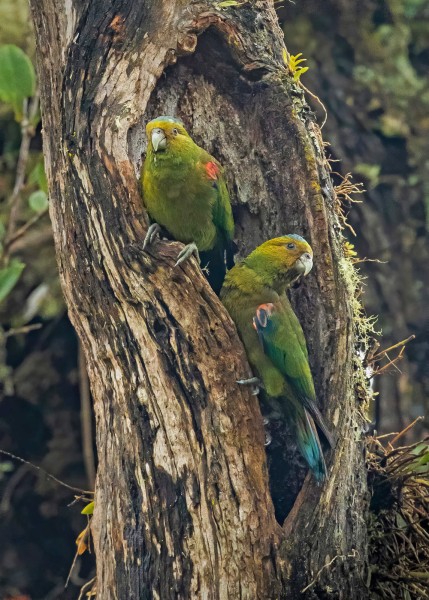
Further updates received 2022 -
A pre-dawn start from Santa Rosa de Cabal, a coffee town in the centre of Colombia, takes us from tarmacked road to dirt track to what seems like a rutted and rock-strewn river bed. As we ascend from 1700 metres to around 3000m, the air grows colder and we pull our coats closer around us. We are on a mission to count the local population of Fuerte’s Parrot, one of the world’s rarest, and this area, known as El Cortaderal, is one of the best places to find it. We gather on a small ridge overlooking a gully lined with moss and lichen-covered trees and wait. This small parrot is extraordinarily well-camouflaged amongst the shades of green and grey and is usually silent when feeding, so spotting even 1 of a population of only some 25 individuals is no easy task. Suddenly, though, the tell-tale squeaky-door calls ring out, and a flock of 12 dive into a nearby tree to feed on their favourite mistletoe. They are here!
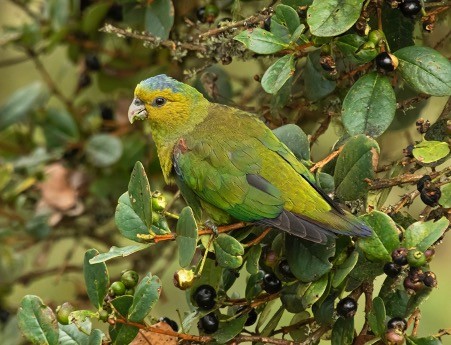
Fuerte's parrot on wild guava fruit
Fuerte’s Parrot (Hapalopsitttaca fuertesii), named after the American bird illustrator Louis Agassiz Fuertes (1874-1927) is also called the Indigo-winged parrot, or in Spanish, the blue-crowned parrot. In fact, when perched, its most prominent feature is a red shoulder and the indigo wings only show themselves in flight. It was thought extinct for more than 90 years and only rediscovered in 2002, and it is only found in a restricted area of the Central Andes of Colombia. Its feeding preferences and distribution have left it extremely vulnerable to habitat loss, but intense conservation action seems to have reversed the decline and it has recently been reclassified from Critically Endangered to Endangered on the IUCN Red List. The total population, however, consists of only some 250-300 individuals.
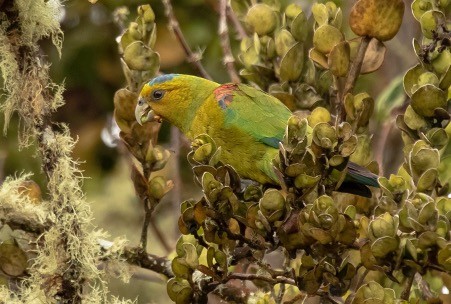
Fuerte's parrot on mistletoe
It is restricted to an altitude range between 2600 and 3600 metres and is found in only 4 areas in 4 departments of Colombia. A flock of 8 Fuerte’s parrots was first encountered in the El Cortaderal area in 2015 and thanks to the work of Fundación Vida Silvestre and its Director, Juan Carlos Noreña Tobón, this population is slowly growing.
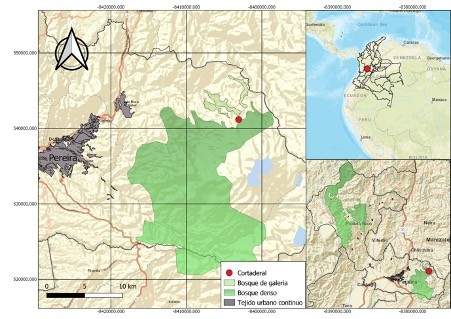
The species is very specific in its food requirements and is therefore extremely sensitive to deforestation pressures. The El Cortaderal population restricts itself to only three food plants – a species of mistletoe (Antidaphne andina), a red-fruit-bearing liana (Muehlenbeckia tamnifolia) and a wild guava (Myrcianthes rhopaloides). Other populations, for example in Anaime and Génova, Tolima seem to feed on a wider variety of fruits and flowers, but this has not been noted in the El Cortaderal population.
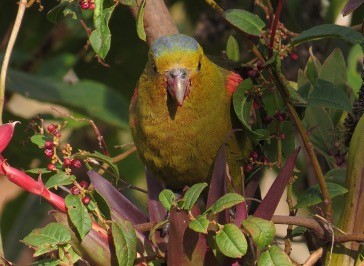
Fundación Vida Silvestre, with the technical and financial support of the Spanish Loro Parque Foundation and grants from Parrot Society UK and the Prince Bernhard Nature Fund, has been carrying out various activities for the protection and conservation of this endangered parrot species. Firstly, it has been very active in the local community raising awareness of the presence and importance of the species, based on the premise that "I do not protect what I do not know". We have contacted the owners of the farms where the parrot is found, and have built relationships with many of their labourers, who often have an intimate knowledge of the wildlife in their area. We have also been carrying out publicity campaigns in and around the town of Santa Rosa de Cabal with talks and video presentations highlighting the precarious situation of Fuerte’s parrot, with the aim of fostering a sense of ownership and pride, which in turns encourages more protection and conservation. A key aspect of this publicity is our work with young people, the next generation of conservationists.
Fundación Vida Silvestre has also been working closely with the municipal authorities which resulted in Fuerte’s Parrot being declared the emblematic bird of the town. Two large murals representing the bird were painted in Santa Rosa (see earlier post), and there will soon be a third. The street where the murals are located has itself been renamed Fuerte’s Parrot Street, and two marble plaques will be installed, one with the name of the street and the other with a picture of the bird and a description in both Spanish and English. There is also now a large image of Fuerte’s parrot in the Council chamber itself. In addition, in the zone where the parrot can be found, 10 billboards have been erected at various points along the access track with information on this species and the birds of the area and the need to protect them.
As a result of this work, Fuerte’s Parrot and the risks to its survival have received a great deal of publicity, both among the local population and within the Town Council of Santa Rosa de Cabal. It has even featured in various books by local writers, and in commercial videos. The principal landowner, and particularly his daughter, are now aware of the special status of their land as a habitat for an endangered species and deforestation has virtually ceased as a consequence. We continue in dialogue with the family, encouraging a transition from deforestation towards conservation, and from conservation towards regeneration, as well as highlighting the potential for them in nature tourism.
As far as the conservation work itself is concerned, 50 artificial nests have been installed with the purpose of facilitating reproduction and reducing competition for nest holes with other parrots and with other species of birds such as woodpeckers. We are trying to increase the availability of food plants for the parrot in the El Cortaderal area, so we have been planting wild guava seeds in the nursery which have germinated and will be planted out on the borders between pasture fields to form living fences, which will both provide food for the parrots and avoid the need to fell trees for fence posts.
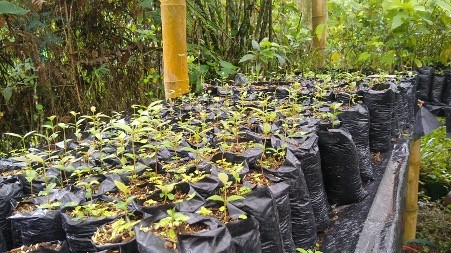
Plant nursery
The mistletoe remains something of a mystery as we do not know whether its seeds need to pass through the gut of an animal or bird in order to germinate or whether there is a way of propagating it artificially. We do know the trees that it tends to parasitize, and we are in the process of collecting seeds of these species in the hope that, in the right conditions, they will germinate.
Meanwhile, back in El Cortaderal, we recently discovered a nesting pair of the parrot and, thanks to the support of the Parrot Society UK, we were able to monitor this nest with camera traps for an extended period and gain valuable information on the parrot’s reproductive behaviour. Fuerte’s parrots normally lay a clutch of three eggs and the nesting period is between January and May – in this case, though, only one fledgling appeared.
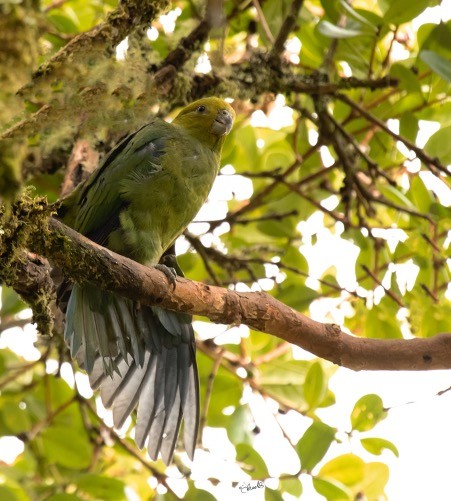
Young fledgling
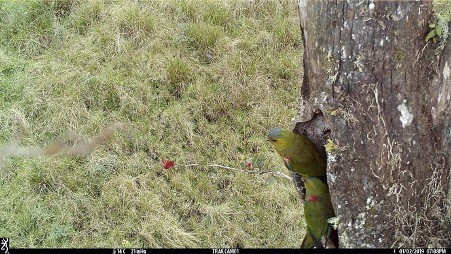
Photograph of the nest site from the camera trap
Thanks to the Parrot Society’s support, we were also able to purchase a camera drone which has allowed us to survey the parrot’s range, identify feeding and nest sites and get advanced warning of any tree-felling in the area. All the work we achieved with Fuerte’s Parrot, especially with respect of the local community, has inspired new initiatives with other vulnerable species in other municipalities in the department of Risaralda. The town of Belén de Umbría, for example, has named a street after the Yellow-Eared Parrot, also endangered. This conservation model puts the community at the heart of its efforts and engenders a sense of identity, pride and belonging among the local population which gives our work enormous impetus.
In Colombia, there is a strong attachment to traditional farming methods which value clear-felling and so-called “improved” land. However, the younger generation is becoming increasingly aware of the need to act in the face of climate change, loss of biodiversity, threats to water courses and the dangers, in a mountainous country, of erosion resulting in landslides and flooding. They are also keen to take advantage of the growth of nature tourism. There are many challenges facing Colombia’s rich biodiversity, but also many signs of hope! The return of Fuerte’s parrot from the brink of extinction is one of these signs that an integrated conservation strategy and local engagement can turn things around.
